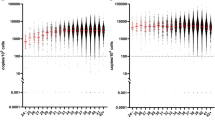Abstract
Co-inheritance of triplicated α-genes can alter the clinical and hematological phenotypes of β-thalassemias. We evaluated the phenotypic diversity and transfusion requirements in β-thalassemia heterozygotes, homozygotes, and normal individuals with associated α-gene triplication. Clinical and hematological evaluation was done and the β-thalassemia mutations characterized by a covalent reverse dot blot hybridization/amplification refractory mutation system. Alpha-globin gene triplication was assessed by multiplex PCR. During the last 2.5 years, 181 β-thalassemia patients and β-thalassemia carriers with an unusual clinical presentation were referred to us for screening for the presence of associated α-globin gene triplication. Twenty-nine of them had associated α-gene triplication (3 β-thalassemia homozygotes or compound heterozygotes and 26 β-thalassemia heterozygotes). One β-thalassemia compound heterozygote [IVS 1–5 (G → C) + CD 41/42 (−CTTT)] was anemic at birth and required blood transfusions unusually early by 6 weeks of age. The second patient (4.5 years) was also clinically severe and became transfusion dependent in spite of having one mild β-thalassemia mutation [Capsite +1 (A → C)]. The third case (3.5 years) who was homozygous for a mild β-gene mutation [−88 (C → T)] with α gene triplication was untransfused. The 26 β-thalassemia heterozygotes with associated triplicated α-genes presented variably, with a β-thalassemia intermedia-like presentation. While screening the family members of all these cases, we found another 10 β-thalassemia heterozygotes and 9 normal individuals with α-globin gene triplication; however, all of them were asymptomatic. Beta-thalassemia carriers, homozygotes, and compound heterozygotes with an unusual presentation should be screened for the possible presence of associated α-globin gene triplication which could influence the clinical and hematological presentation.
Similar content being viewed by others
Abbreviations
- HPLC:
-
High-performance liquid chromatography
- CRDB:
-
Covalent reverse dot blot hybridization
- ARMS:
-
Amplification refractory mutation system
- TI:
-
Thalassemia intermedia
References
Weatherall DJ, Clegg JB. The thalassemia syndromes. 4th Ed. Blackwell Science; 2001.
Camaschella C, Kattamis A, Petroni D (1997) Different haematological phenotypes caused by the interaction of triplicated α-globi. Am J Hematol 55:83–88
Goossens M, Dozy AM, Embury SH, Zachariada Z, Hadjiminas M, Stamatoyannopoulos G et al (1980) Triplicated α-globin loci in humans. Proc Natl Acad Sci USA 77:518–521
Colah R, Goraksahkar A, Lu C, Nadkarni A, Desai S, Pawar N et al (1997) Application of covalent reverse dot blot hybridization for rapid prenatal diagnosis of the common Indian thalassemia syndromes. Indian J Haematol Blood Transfus 15:10
Old JM (2001) DNA based diagnosis of hemoglobin disorders. In: Steinberg MH, Forget BG, Higs DR and Nagel RL (Eds.), Disorders of hemoglobin—genetics, pathophysiology and clinical management. Cambridge University Press 2001; pp 941–948.
Tan A, Quah T, Low P, Chang S (2001) A rapid and reliable 7 deletion multiplex polymerase chain reaction assay for α-thalassemia. Blood 98:250–251
Rachmilewitz E, Giardina P (2011) How I treat thalassemia. Blood 118(13):3479–3488
Musallam K, Taher A, Rachmilewitz E (2012) β thalassemia intermedia: a clinical perspective. Cold Spring Harb Perspect Med 2(7):a013482
Musallam K, Revella S, Vichinsky E, Rachmilewitz E (2013) Non-transfusion dependent thalassemias. Haematologica 98:833–844
Henni T, Belhani M, Morle F, Bachir D, Tabone P, Colonna P et al (1985) α-Globin gene triplication in severe heterozygous β-thalassemia. Acta Haematol 74:236–239
Colah R, Nadkarni A, Mukerjee M, Goraksahkar A, Surve R, Mohanty D (1997) β-Thalassemia heterozygotes with α-globin gene triplication. Br J Hematol 97:506–507
Urbinati F, Madigan C, Malik P (2006) Pathophysiology and therapy for hemoglobinopathies. Part II: thalassemias. Expert Rev Mol Med 8:1–26
Treager- Synodinos J, Kanavakis E, Vrettou C, Maragoudaki E, Michael TH, Metaxotou- Mavromati A et al (1996) The triplicated α- globin gene locus in β-thalassemia heterozygous: clinical, haematological, biosynthetic and molecular studies. Br J Haematol 95:467–471
Panigrahi I, Mahapatra M, Kumar R, Cahudhary VP, Sexsena R (2006) Jaundice and α-gene triplication in β-thalassemia: association or causation? Hematology 11:109–112
Giordano PC, Bakker- Verwij M, Harteveld C (2009) Frequency of α-globin gene triplication and their interaction with β-thalassemia mutations. Hemoglobin 33:124–131
Premawardhena A, Fisher C, Olivieri N, De Silver S, Sloane- Stanley J, Wood W et al (2005) A novel molecular basis for β-thalassemia intermedia poses new questions about its pathophysiology. Blood 106:3251–3255
Fallah M, Zadeh-Vakili A, Aleyasin S, Mahdian R, Karimipour M, Raeisi M et al (2009) Molecular characterization of thalassemia intermedia, due to co-inheritance of homozygous α triplication and IVS-I-5 β-thalassemia. Blood Cell Mol Dis 43:158–160
Paleari R, Giambona A, Cannata M, Leto F, Maggio A, IFCC Working Group Standardization of HbA2 (2007) External quality assessment of hemoglobin A2 measurement: data from an Italian pilot study with fresh whole blood samples and commercial HPLC systems. Clin Chem Lab Med 45:88–92
Nadkarni A, Tamhankar A, Surve R, Shirsat R, Colah R, Gorakshakar A et al (1997) Effect of associated α-thalassemia and α-gene triplication on haematological profile of β-thalassemia heterozygotes and normal individuals. Med Sci Res 25:685–686
Acknowledgments
We are thankful to all the clinicians for referring the patients.
Authorship contributions
PM, DU, and MG carried out the molecular analysis for alpha-gene triplication, and PM wrote the first draft of the manuscript. PS helped with the molecular analysis for β-thalassemia, AN supervised the laboratory work, and CS clinically evaluated the patients. RC designed the study, helped with the analysis of the data, and finalized the manuscript. KG provided inputs for the manuscript. All the authors have read and approved the manuscript.
Conflict of interest
The authors declare that they have no conflict of interest.
Author information
Authors and Affiliations
Corresponding author
Rights and permissions
About this article
Cite this article
Mehta, P.R., Upadhye, D.S., Sawant, P.M. et al. Diverse phenotypes and transfusion requirements due to interaction of β-thalassemias with triplicated α-globin genes. Ann Hematol 94, 1953–1958 (2015). https://doi.org/10.1007/s00277-015-2479-8
Received:
Accepted:
Published:
Issue Date:
DOI: https://doi.org/10.1007/s00277-015-2479-8




